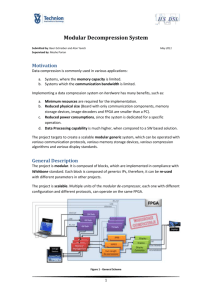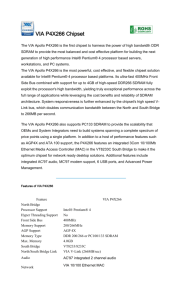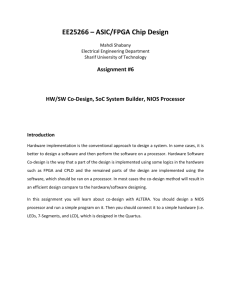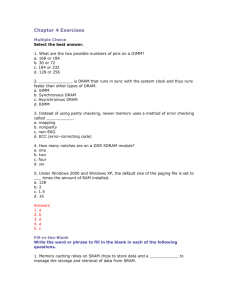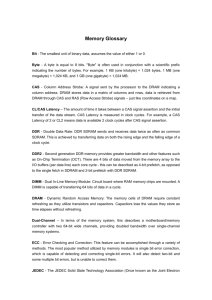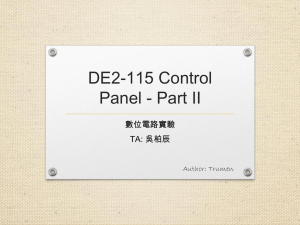a Engineer-to-Engineer Note EE-210
advertisement
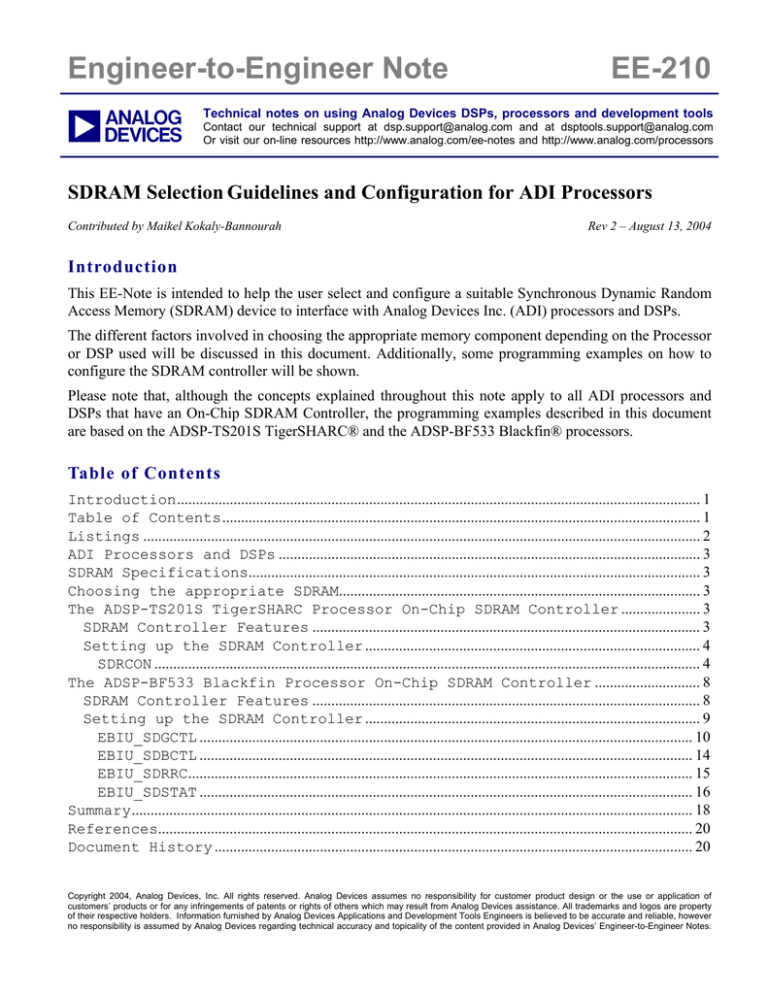
Engineer-to-Engineer Note a EE-210 Technical notes on using Analog Devices DSPs, processors and development tools Contact our technical support at dsp.support@analog.com and at dsptools.support@analog.com Or visit our on-line resources http://www.analog.com/ee-notes and http://www.analog.com/processors SDRAM Selection Guidelines and Configuration for ADI Processors Contributed by Maikel Kokaly-Bannourah Rev 2 – August 13, 2004 Introduction This EE-Note is intended to help the user select and configure a suitable Synchronous Dynamic Random Access Memory (SDRAM) device to interface with Analog Devices Inc. (ADI) processors and DSPs. The different factors involved in choosing the appropriate memory component depending on the Processor or DSP used will be discussed in this document. Additionally, some programming examples on how to configure the SDRAM controller will be shown. Please note that, although the concepts explained throughout this note apply to all ADI processors and DSPs that have an On-Chip SDRAM Controller, the programming examples described in this document are based on the ADSP-TS201S TigerSHARC® and the ADSP-BF533 Blackfin® processors. Table of Contents Introduction........................................................................................................................................... 1 Table of Contents............................................................................................................................... 1 Listings .................................................................................................................................................... 2 ADI Processors and DSPs ................................................................................................................ 3 SDRAM Specifications........................................................................................................................ 3 Choosing the appropriate SDRAM................................................................................................ 3 The ADSP-TS201S TigerSHARC Processor On-Chip SDRAM Controller ..................... 3 SDRAM Controller Features ....................................................................................................... 3 Setting up the SDRAM Controller ......................................................................................... 4 SDRCON ................................................................................................................................................. 4 The ADSP-BF533 Blackfin Processor On-Chip SDRAM Controller ............................ 8 SDRAM Controller Features ....................................................................................................... 8 Setting up the SDRAM Controller ......................................................................................... 9 EBIU_SDGCTL ................................................................................................................................... 10 EBIU_SDBCTL ................................................................................................................................... 14 EBIU_SDRRC...................................................................................................................................... 15 EBIU_SDSTAT ................................................................................................................................... 16 Summary..................................................................................................................................................... 18 References.............................................................................................................................................. 20 Document History ............................................................................................................................... 20 Copyright 2004, Analog Devices, Inc. All rights reserved. Analog Devices assumes no responsibility for customer product design or the use or application of customers’ products or for any infringements of patents or rights of others which may result from Analog Devices assistance. All trademarks and logos are property of their respective holders. Information furnished by Analog Devices Applications and Development Tools Engineers is believed to be accurate and reliable, however no responsibility is assumed by Analog Devices regarding technical accuracy and topicality of the content provided in Analog Devices’ Engineer-to-Engineer Notes. a Listings Figure Figure Figure Figure Figure Figure Table Table Table Table Table Table Table Table Table Table Table Code Code Code Code 1. 2. 3. 4. 5. 6. ADSP-TS201S SDRAM Control Register (SDRCON) ........................................ 5 ADSP-BF533 SDRAM EBIU_SDGCTL Register – Upper 16-bits .............. 10 ADSP-BF533 SDRAM EBIU_SDGCTL Register – Lower 16-bits .............. 11 ADSP-BF533 SDRAM Bank Control Register (EBIU_SDBCTL)................. 14 ADSP-BF533 EBIU_SDRRC Register...................................................................... 15 ADSP-BF533 SDRAM Status Register (EBIU_SDSTAT) ............................... 16 1. ADSP-TS201S TigerSHARC Processor and SDRAMs compatibility ......... 4 2. SDRAM “A” CAS Latency................................................................................................ 5 3. SDRAM “A” Specifications ........................................................................................ 6 4. Relevant SDRAM “A” Timing Specifications .................................................. 7 5. ADSP-BF533 Blackfin Processor and SDRAMs compatibility ................ 9 6. SDRAM “D” CAS Latency.............................................................................................. 11 7. Relevant SDRAM “D” Timing Specifications ................................................ 12 8. SDRAM “D” Specifications ...................................................................................... 15 9. TigerSHARC Processors with On-Chip SDRAM Controller...................... 19 10. Blackfin Processors with On-Chip SDRAM Controller ........................ 19 11. SHARC DSPs with On-Chip SDRAM Controller.............................................. 20 1. 2. 3. 4. SDRCON Settings using header file defts201.h........................................... 7 SDRCON Settings without the use of header files.................................... 8 SDRAM Control Registers Settings using header file defBF532.h 17 SDRAM Control Registers Settings without header files ................... 18 SDRAM Selection Guidelines and Configuration for ADI Processors (EE-210) Page 2 of 20 a ADI Processors and DSPs Several Analog Devices processors and DSPs have been designed with an on-chip SDRAM controller: • • • The ADSP-21065L and ADSP-21161N SHARC DSPs. The ADSP-TS101S, ADSP-TS201S, ADSPTS202S and ADSP-TS203S TigerSHARC processors. The ADSP-BF531, ADSP-BF532, ADSPBF533 and ADSP-BF535 Blackfin processors. Having an On-Chip SDRAM Controller allows to gluelessly interface to SDRAM memory devices without the necessity of incorporating additional components to the system, resulting in a cost-effective solution. SDRAM Specifications Choosing SDRAM The ADSP-TS201S TigerSHARC Processor On-Chip SDRAM Controller Before an SDRAM device can be selected, the user needs to understand the features and specifications of the chosen processor. SDRAM Controller Features With the factors previously explained in mind, these are the relevant ADSP-TS201S processor on-chip SDRAM controller characteristics for choosing the appropriate memory device: • • • • • • • • • • • All these characteristics are defined in the SDRAM device datasheet and must meet the specifications of the on-chip SDRAM controller of the processor being used in order to be able to gluelessly interface to it. appropriate As an example, let’s examine the ADSP-TS201S TigerSHARC and the ADSP-BF533 Blackfin processors and their compatibility with different SDRAM devices. There are several factors that need to be considered when selecting an SDRAM device to interface with ADI’s processors or DSPs, which are common across all families: Supported operating voltage Maximum supported operating frequency Maximum supported memory I/O size and number of banks Column Address Strobe (CAS) latency Refresh rate Burst length Page size Initialization sequence the • • • • • • • Supported operating Voltage o 3.3 and 2.5 V Maximum supported operating Frequency o 125 MHz Maximum supported memory o 256 Mbytes (64 M x 32 bits or 32 M x 64 bits) per external SDRAM bank Number of internal SDRAM banks o 2 or 4 banks. Column Address Strobe (CAS) latency o Programmable value: 1 to 3 system clock cycles (SCLK) Refresh rate o Programmable value: 32 to 64 ms. Burst Length o Full page burst Page size o Programmable value to: 256, 512 or 1024 words. Initialization sequence o Programmable sequence: MRSÖREF, or REFÖMRS. SDRAM Selection Guidelines and Configuration for ADI Processors (EE-210) Page 3 of 20 a For the aid of this example, devices A and B have been selected. Are these two SDRAM devices compatible with the ADSP-TS201S TigerSHARC Processor? Let’s look at the different specifications to be met: SDRAM Features ADSP-TS201S SDRAM Controller SDRAM “A” 1 Meg x 32 x 4 banks Voltage 2.5 or 3.3 V 3.3 V Max. Frequency 125 MHz Max. Mem. Size OK SDRAM “B” 4 Meg x 32 x 2 banks OK 143/166 MHz 9 9 100/133 MHz 9 9 64 Mx32 or 32 Mx64 (256 Mbytes) per external SDRAM bank 16 Mbytes 9 32 Mbytes 9 Supported I/O x32, x64 x32 Number of SDRAM Banks 2 or 4 banks 4 banks CAS Latency 1 to 3 cycles 1 to 3 cycles Refresh Rate 32 and 64 ms 64 ms Burst Length Full-page burst 1,2,4,8 or Full-page Page Size 256, 512, and 1024 256 Init. Sequence MRSÖREF or REFÖMRS REFÖMRS 9 9 9 9 9 9 9 3.3 V x32 2 banks 1 to 3 cycles 64 ms 9 9 9 9 2048 8 8 MRSÖREF 9 1 Table 1. ADSP-TS201S TigerSHARC Processor and SDRAMs compatibility As it can be seen from the table above, device B does not meet all specifications: it only supports burst length of one (and not full page burst) and its page size is 2048 words (which is bigger than the maximum supported page size of 1024 words). On the other side, it can be seen that device A meets all requirements, and therefore, it can be properly interfaced to the ADSP-TS201S TigerSHARC Processor. Setting up the SDRAM Controller Now that a compatible SDRAM device has been selected (SDRAM A), the next step is to properly configure the SDRAM control register (SDRCON) according to specifications given in Table 1. the memory SDRCON The initial value of the SDRCON register after reset is zero, meaning that the SDRAM is disabled. The bit descriptions for this register are shown in Figure 1. Note that although this is a 32-bit register, only the lower 16-bits are shown. The upper 16-bits are reserved and should always be set to zero. For more details, please refer to SDRAM Interface chapter of the ADSP-TS201 TigerSHARC Processor Hardware Reference. SDRAM Selection Guidelines and Configuration for ADI Processors (EE-210) Page 4 of 20 a Figure 1. ADSP-TS201S SDRAM Control Register (SDRCON) So how do we correctly set up the SDRAM Control register (SDRCON)? Let’s have a look at a typical SDRAM device datasheet to determine the settings for the different bits: • SDRAM ENABLE. This bit must be set when SDRAM is present in the system (SDRCON_ENBL). L To use the above bit definition (SDRCON_ENBL), the file defTS201.h should be included in the source code (see Code 1 ). This file comes with the VisualDSP++™ 32-bit Tools and can be found in the directory: C:\...\AnalogDevices\VisualDSP\TS\include. • CAS LATENCY. This parameter specifies the delay between a read command and the time data becomes available. It does not apply to write accesses. CAS Latency is generally specified in the datasheet as shown in Table 2. Table 2. SDRAM “A” CAS Latency SDRAM Selection Guidelines and Configuration for ADI Processors (EE-210) Page 5 of 20 a Assuming the external port runs with a 100MHz system clock (SCLK), the selected CAS LATENCY is 2 (SDRCON_CLAT2). Note that, as specified in Table 1, the maximum supported SCLK frequency by the ADSP-TS201S is 125 MHz. The selected frequency for this example, 100 MHz, corresponds to the default value of the ADSP-TS201S EZ-KIT Lite™. L Some SDRAM timing specifications (CL, tRAS, tRP, etc) may vary depending on the speed grade of the SDRAM being used. Table 3. SDRAM “A” Specifications As it can bee seen in Table 3, the maximum number of addressable columns is 256 (A07). Thus, the page size should be configured to 256 (SDRCON_PG256). • Settings in this particular example are optimized for a dedicated operating frequency (100 MHz) and speed grade part (-6). Variations in the clock frequency and/or speed grade of the SDRAM device also require modifying the parameter settings. • The refresh count is provided in Table 3 as 4 K, and is also generally listed under the SDRAM features list as: 64 ms, 4,096-cycle refresh (15,6 µs/row) With this in mind, the refresh rate is calculated as follows: PIPE DEPTH. In systems where several SDRAMs are used in parallel, and external buffers are needed, this bit should be enabled. tREF ⎞ ⎛ Cycles= ⎜ SOCCLK⋅ ⎟ Rows⎠ ⎝ Where: SOCCLK = 250 MHz (default ADSP-TS201S EZ-KIT Lite value) tREF = SDRAM refresh period Rows = number of row addresses This is valid if the nominal capacitive pin loading is exceeded (30 pF/pin). In this particular example (ADSP-TS201S EZ-KIT Lite), there are only two SDRAMs where no buffering of the signals is needed (SDRAM pin capacitance 2x5 pF+10 pF (PCB) ≈ 20 pF). Therefore, this bit should be cleared (SDRCON_PIPE1). • REFRESH RATE. These bits select the refresh counter to coordinate the Processor’s SOC clock rate (SOCCLK) with the SDRAM device’s required refresh rate. Therefore, Refresh rate = 250 MHz × 15,6 µs = 3900 cycles In order to be able to guarantee that this number is met, a refresh rate equal to or smaller than 3900 cycles should be selected. In this case, and since the processor’s controller supports up to 3700 cycles only, this should be the selected refresh rate (SDRCON_REF3700). PAGE BOUNDARY. These bits define the page size, in number of words, of the SDRAM’s banks. This number corresponds to the number of addressable columns. • PRC TO RAS DELAY. This parameter determines the Precharge to RAS delay, which is typically given in the datasheet as tRP. SDRAM Selection Guidelines and Configuration for ADI Processors (EE-210) Page 6 of 20 a Table 4 illustrates some of the SDRAM timing specifications that can be found in the datasheet. As it can be seen, the device with speed grade -6 has tRPmin = 18ns. At 100 MHz, this gives a minimum time of 1.8 cycles. Therefore, tRP should be set to 2 cycles (SDRCON_PC2RAS2). Table 4. Relevant SDRAM “A” Timing Specifications • This means that the device minimum requirements after power up are: RAS TO PRC DELAY: This parameter determines the RAS to Precharge delay, which is typically given in the datasheet as tRAS. PRE + 2×Autorefresh + MRS When setting this bit to 1 the controller issues the following sequence of commands: As shown in Table 4, this SDRAM device has tRASmin = 42 ns. At 100 MHz, this gives a minimum time of 4.2 cycles. Therefore, tRAS should be set to 5 cycles (SDRCON_RAS2PC5). • INIT SEQUENCE: This bit determines the SDRAM initialization sequence at power up. From the Initialization section in the datasheet: PRE + 8×Autorefresh + MRS This meets the power-up timing specifications of the selected SDRAM. Therefore, this bit should be set (SDRCON_INIT). • “[…] Once the 100µs delay has been satisfied with at least one COMMAND INHIBIT or NOP command having been applied, a PRECHARGE command should be applied. […] Once in the idle state, two AUTO REFRESH cycles must be performed. After the AUTO REFRESH cycles are complete, the SDRAM is ready for Mode Register programming.” EMR ENABLE. This bit should only be set when interfacing to Low-Power SDRAM (2.5 Volts) devices. Otherwise, this bit should remain cleared. From the datasheet Features list: Single +3.3 V ±0.3 V power supply Therefore, since this is a standard SDRAM device, this bit should be cleared (SDRCON_EMRS). Thus, with the above settings in mind, the SDRCON register should be set to: #include <defts201.h> xr0 = SDRCON_INIT SDRCON_REF3700 SDRCON = xr0;; | SDRCON_RAS2PC5 | SDRCON_PG256 | SDRCON_PC2RAS2 | SDRCON_CLAT2 | | SDRCON_ENBL;; Code 1. SDRCON Settings using header file defts201.h SDRAM Selection Guidelines and Configuration for ADI Processors (EE-210) Page 7 of 20 a As it can be seen in Code 1, any of the SDRCON bits that should be cleared (i.e. PIPE DEPTH and EMR ENABLE) are simply ignored and not included in the bit settings above (remember that by default SDRCON = 0x0000 0000). j11 = j31 + 0x00005983;; SDRCON = j11;; // 0000000000000000 // |---RESERVED---| // // // // // // // // // // In the case were the bit definitions (“defts201.h”) were not used, the SDRCON register should be programmed as follows: 0 1 011 00 11 0 00 0 01 1 | | | | | | | | | | | | | | | | | | | || | | | | | | | |--| | | | | | | |-----| | | | | | |-------| | | | | |----------| | | | |------------| | | |---------------| | |------------------| |----------------------|------------------------- SDRAM Enabled CAS LATENCY = 2 PIPE DEPTH = 0 PAGE BOUNDARY = 256 Reserved REFRESH RATE = 3700 tRP = 2 tRAS = 5 INIT SEQUENCE PRE+MRS EMR DISABLED Code 2. SDRCON Settings without the use of header files After SDRCON is properly configured with the value previously discussed, the controller will perform a Mode Register Set (MRS) command, which initializes the external memory device. Please note that during this MRS command, some of the SDRAM parameters, which are not programmable in SDRCON, are initialized. This is the case for the Burst Length and Type, which are hardwired to full page burst and sequential. At this point, the user can safely start accessing the SDRAM. The ADSP-BF533 Processor On-Chip Controller Blackfin SDRAM Like in the previous example, before an SDRAM device can be selected, the user needs to understand the features and specifications of the chosen Processor. Note that, although this section refers to ADSP-BF533, the same concepts apply for ADSP-BF532 and ADSP-BF531, since SDRAM Controller (SDC) functionality is same for all three parts. the the the the SDRAM Controller Features These are the relevant ADSP-BF533 Processor on-chip SDRAM controller characteristics for choosing the appropriate memory device: • • • • Supported operating Voltage o 3.3 and 2.5 V Maximum supported operating Frequency o 133 MHz Maximum supported memory o 128 Mbytes (64 M x 16 bits) Number of banks SDRAM Selection Guidelines and Configuration for ADI Processors (EE-210) Page 8 of 20 a • • • • o 4 banks. Column Address Strobe (CAS) latency o Programmable value: 2 or 3 system clock cycles (SCLK) Refresh rate o Programmable value: 1 to 4095 system clock cycles (SCLK). Burst Length o Burst length of 1 Page size • o Programmable value to: 512, 1024 2048 or 4096 bytes. Initialization sequence o Programmable sequence: MRSÖREF, or REFÖMRS. For the aid of this example, devices C and D have been selected. Are these two SDRAM devices compatible with the ADSP-BF533 Blackfin Processor? Let’s look at the different specifications to be met: SDRAM Features ADSP-BF533 SDRAM Controller SDRAM “C” 4 Meg x 16 x 2 banks Voltage 2.5 and 3.3 V 3.3 V Max. Frequency 133 MHz 143/166 MHz Max. Mem. Size 64 M x 16 (128 Mbytes) 16 Mbytes Supported I/O x16 x16 9 9 9 9 Number of SDRAM Banks 4 banks 2 banks 8 CAS Latency 2 or 3 cycles 1 to 3 cycles Refresh Rate Programmable (SDRRC) 64 ms 9 9 Burst Length 1 Full-page 8 Page Size (bytes) 512, 1024, 2048 and 4096 2048 Init. Sequence MRSÖREF or REFÖMRS REFÖMRS OK 9 9 SDRAM “D” 4 Meg x 16 x 4 banks 3.3 V 100/143 MHz 32 Mbytes x16 4 banks 1 to 3 cycles 64 ms 1,2,4,8 or Full-page 1024 MRSÖREF OK 9 9 9 9 9 9 9 9 9 9 Table 5. ADSP-BF533 Blackfin Processor and SDRAMs compatibility As it can be seen from the table above, device C does not meet all specifications: it has 2 banks (4 banks supported only) and it supports full page burst (burst length of one supported only). On the other side, it can be seen that device D meets all requirements, and therefore, it can be properly interfaced to the ADSP-BF533 Blackfin processor. Setting up the SDRAM Controller Now that a compatible SDRAM device has been selected (SDRAM D), the next step is to properly configure the different SDRAM control registers according to the memory specifications given in Table 5. After a processor’s hardware or software reset, the SDC clocks are enabled. However, the SDC must be configured and initialized. SDRAM Selection Guidelines and Configuration for ADI Processors (EE-210) Page 9 of 20 a In order to set up the SDC and start the SDRAM power-up sequence, the SDRAM Refresh Rate Control register (EBIU_SDRRC), the SDRAM Memory Bank Control register (EBIU_SDBCTL), and SDRAM Memory Global Control register (EBIU_SDGCTL) must be written, and a transfer must be started to SDRAM address space. EBIU_SDGCTL The SDRAM Memory Global Control Register (SDGCTL) includes all programmable parameters associated with the SDRAM access timing and configuration. The bit descriptions for EBIU_SDGCTL are shown in Figure 2 and Figure 3. The following sections will briefly describe each one of the registers mentioned above as well as their bit descriptions. Figure 2. ADSP-BF533 SDRAM EBIU_SDGCTL Register – Upper 16-bits SDRAM Selection Guidelines and Configuration for ADI Processors (EE-210) Page 10 of 20 a Figure 3. ADSP-BF533 SDRAM EBIU_SDGCTL Register – Lower 16-bits So how do we correctly set up the SDRAM Global Control register (EBIU_SDGCTL)? Let’s have a look at a typical SDRAM device datasheet to determine the settings for the different bits: • SCTLE. This bit must be set for SDC operation and is enabled by default at reset (SCTLE). L Note that, as specified in Table 5, the maximum supported SCLK frequency by the ADSP-BF533 is 133 MHz. The selected frequency for this example, 54 MHz, corresponds to the default value of the ADSP-BF533 EZ-KIT Lite. L To use the above bit definition (SCTLE), the file defBF533.h should be included in the source code (see Code 3). This file comes with the VisualDSP++ 16-bit Tools and can be found in the directory: Settings in this particular example are optimized for a dedicated operating frequency (54 MHz) and speed grade part (-75). Variations in the clock frequency and/or speed grade of the SDRAM device also require modifying the parameter settings. C:\..\AnalogDevices\VisualDSP\Blackfin\include • CL. This parameter specifies the delay between a read command and the time data becomes available. It does not apply to write accesses. CAS Latency is generally specified in the datasheet as shown in Table 6. Table 6. SDRAM “D” CAS Latency Assuming the external port runs with a 54MHz system clock (SCLK), the selected CAS LATENCY is 2 (CL_2). Some SDRAM timing specifications (CL, tRAS, tRP, etc) may vary depending on the speed grade of the SDRAM being used. • PASR. When EMREN (Extended Mode Register Enable) is set, the PASR bits (in combination with the TCSR bit) control the value written to the Extended Mode Register. This only applies for mobile low-power SDRAMs (2.5 V). Since SDRAM “D” is standard LVTTL (3.3 V), these bits can be ignored (PASR_X). • TRAS. This parameter determines the RAS to Precharge delay, which is typically given in the datasheet as tRAS. SDRAM Selection Guidelines and Configuration for ADI Processors (EE-210) Page 11 of 20 a Table 7 illustrates some of the SDRAM timing specifications that can be found in the datasheet. As it can be seen, this SDRAM device (speed grade -75) has tRASmin = 44 ns. At 54 MHz, this gives a minimum time of 2.38 cycles. Therefore, tRAS should be set to 3 cycles (TRAS_3). • From Table 7, the device with speed grade 75 has tRCDmin = 20 ns. At 54 MHz, this gives a minimum time of 1.08 cycles. Therefore, tRCD should be set to 2 cycles (TRCD_2). • TRP. This parameter determines the Precharge to RAS delay, which is typically given in the datasheet as tRP. As shown in Table 7, the device with speed grade -75 has tWRmin = 1CLK+7.5 ns = 26 ns. At 54 MHz, this gives a minimum time of 1.4 cycles. Therefore, tWR should be set to 2 cycles (TRW_2). As shown in Table 7, the device with speed grade -75 has tRPmin = 20ns. At 54 MHz, this gives a minimum time of 1.08 cycles. Therefore, tRP should be set to 2 cycles (TRP_2). • TWR. This parameter determines the delay between a write and a Precharge command. It is typically given as tWR. TRCD. This parameter determines the delay between bank activation and the first read/write from/to SDRAM. It is typically given as tRCD. Table 7. Relevant SDRAM “D” Timing Specifications L specifications for tXSR, tRAS or tRP should be increased by 1. Typically, increasing tRAS gives better performance, since it is used less often by the controller. The value of tXSR is equal to tRAS + tRP. This is fixed by the controller. Thus, the user must make sure that the specification for tXSR is met when selecting the values for tRAS and tRP. If tRAS + tRP does not meet the • PUPSD. The Power-up Start Delay bit optionally delays the power-up start sequence SDRAM Selection Guidelines and Configuration for ADI Processors (EE-210) Page 12 of 20 a for 15 SCLK cycles. This is useful for multiprocessing systems sharing an external SDRAM. • Since this example is based on the ADSPBF533 EZ-KIT Lite (single processor system), the setting for this bit does not apply (PUPSD). • This mode is used to reduce the application’s power consumption to a minimum when the SDRAM is not being accesses for an extended period of time. This does not apply for this example, therefore this bit should be cleared (SRFS). PSM. This bit determines the SDRAM power-up sequence. From the Initialization section in the datasheet: “[…] Once the 100 µs delay has been satisfied with at least one COMMAND INHIBIT or NOP command having been applied, a PRECHARGE command should be applied. • […] Once in the idle state, two AUTO REFRESH cycles must be performed. After the AUTO REFRESH cycles are complete, the SDRAM is ready for Mode Register programming.” PRE + 2×Autorefresh + MRS • PRE + 8×Autorefresh + MRS This meets the power up timing specifications of the selected SDRAM device. Therefore, this bit should be cleared (PSM). • PSSE. The Power-up Sequence Start enable bit must be set to 1 to enable the SDRAM power-up sequence (PSSE). L A read or write access must be done to enable SDRAM address space in order to have the external bus granted to the SDC so that the SDRAM power-up sequence may occur. EBUFE. In systems where several SDRAM devices are used in parallel, and external buffers are needed, this bit should be enabled (=1). This is valid if the nominal capacitive pin loading is exceeded (50 pF/pin) In this particular example (ADSP-BF533 EZ-KIT Lite), there is only one SDRAM where no buffering of the signals is needed (SDRAM pin capacitance 5 pF+10 pF (PCB) ≈ 15 pF). Therefore, this bit should be cleared (EBUFE). This means that the device minimum requirements after power up are: When clearing this bit (=0) the controller issues the following sequence of commands: SRFS. When setting the Self-Refresh bit (=1), the SDC completes any active transfers and then puts the SDRAM into self-refresh mode. The next access to SDRAM will take the device out of self-refresh mode, performing the transfer to or from SDRAM. FBBRW. The Fast Back-to-Back Read to Write bit enables SDRAM read followed by write to occur on consecutive cycles. In many systems, this is not possible because the turnoff time of the SDRAM data pins is too long. When this bit is 0, a clock cycle is inserted between read accesses followed by write accesses. For this example, an extra cycle is added between read and write transactions, therefore this bit should be cleared (FBBRW). • EMREN. This bit should only be set when interfacing to mobile low-power SDRAM (2.5 V) devices. Otherwise, this bit should remain cleared. SDRAM Selection Guidelines and Configuration for ADI Processors (EE-210) Page 13 of 20 a From the SDRAM “D” datasheet Features list: Single +3.3 V ±0.3 V power supply Therefore, since this is a standard LVTTL (3.3 V) SDRAM device, this bit should be cleared. (EMREN) • TCSR. When EMREN (Extended Mode Register Enable) is set, the TCSR bit (in combination with the PASR bits) controls the value written to the Extended Mode Register. This only applies for mobile low-power SDRAMs (2.5 V). Since SDRAM “D” is standard LVTTL (3.3 V), this bit can be ignored (TCSR). • CDDBG. The Control Disable During Bus Grant bit is used to enable or disable the SDRAM control signals when the external memory interface is granted to an external controller. Otherwise, these signals continue to be driven during grant. In this example, the control signals are not shared with any external controller, therefore this bit should be cleared (CDDBG). A programming example of the EBIU_SDGCTL SDRAM control register is shown at the end of this section (Code 3). L ALL reserved bits in this register must always be written with zeros. EBIU_SDBCTL The SDRAM Memory Bank Control Register includes external bank specific programmable parameters of the SDRAM. This register is 16-bit wide and uses the access timing parameters defined in the EBIU_SDGCTL register. The bit descriptions for EBIU_SDBCTL are shown in Figure 4. If this bit is set (=1), the control signals are three-stated when bus grant is active. Figure 4. ADSP-BF533 SDRAM Bank Control Register (EBIU_SDBCTL) • EBE. This bit is used to enable or disable the external SDRAM bank. This bit must be enabled when accessing the external SDRAM bank. If disabled, any access to SDRAM address space generates an internal SDRAM Selection Guidelines and Configuration for ADI Processors (EE-210) Page 14 of 20 a error. Therefore, this bit should be set to 1 (EBE). • EBSZ. This bit determines the SDRAM External Bank Size according to the density and I/O configuration of the SDRAM device used. In this example, the selected SDRAM (device “D” -Table 8) is: 16 M x 16. Therefore: EBSZ = 16 M × 16 = 256 Mbit = 32 Mbyte In order to be able to calculate the page size, the following formula is used: 16-bit SDRAM banks: page size = 2(CAW+1) Thus, the SDRAM External Bank Size should be set to 32 Mbyte (EBSZ_32). where CAW is the column address width of the SDRAM, plus 1 because the SDRAM bank is 16 bits wide. For more details on the supported EBSZ encodings refer to the SDRAM Configurations Supported section of the SDRAM Controller in the External Bus Interface Unit chapter of the ADSP-BF533 Blackfin Processor Hardware Reference. As shown in Table 8, the column address width for device “D” is 512 bits (A0-A8). Therefore, EBCAW = 9 bits (01) (EBCAW_9). L Although the smallest supported SDRAM external bank size is 16Mbytes, smaller devices can also be interfaced to the ADSP-BF533. In this case, the external bank size in SDBCTL should be configured to 16 Mbyte (EBSZ_16), but the user’s code should not access any SDRAM address outside the physical memory size of the SDRAM being used. Exceeding this range will result in looping back to the first SDRAM memory location corrupting existing data. • Table 8. SDRAM “D” Specifications EBCAW. These bits determine the SDRAM external bank column address width. As previously explained (Table 5) page sizes of 512 bytes, 1 Kbyte, 2 Kbytes and 4 Kbytes are supported. Thus: Page size = 2(9+1) = 1024 = 1 Kbyte A programming example of the EBIU_SDBCTL SDRAM control register is shown at the end of this section (Code 3). EBIU_SDRRC The SDRAM Refresh Rate Control Register (EBIU_SDRRC) provides a flexible mechanism for specifying the Auto-Refresh timing. Since the clock supplied to the SDRAM can vary, the SDC provides a programmable refresh counter which has a period based on the value programmed into the RDIV field of this register that coordinates the supplied clock rate with the SDRAM device’s required refresh rate. The bit descriptions for EBIU_SDRRC are shown in Figure 5. Figure 5. ADSP-BF533 EBIU_SDRRC Register SDRAM Selection Guidelines and Configuration for ADI Processors (EE-210) Page 15 of 20 a • RDIV =((54 MHz x 64 ms)/8192) - (3+2) = 416.87 ≈ 416 = 0x1A0 clock cycles RDIV. The value to be written to this register can be calculated using the following formula: Therefore, RDIV must be programmed to 0x1A0 (hex). RDIV =((fSCLK x tREF)/NRA)-(tRAS + tRP) Where: fSCLK = SDRAM clock frequency tREF = SDRAM refresh period NRA = number of row addresses tRAS = tRAS in clock cycles tRP = tRP in clock cycles For this example, the SCLK frequency is 54 MHz. The refresh count and number of rows are provided in Table 8 as 8K cycle period and 8 K rows. The refresh period is also generally listed under the SDRAM features list as: 64 ms, 8,192-cycle refresh tRAS and tRP are defined in EBIU_SDGCTL as 3 and 2 cycles respectively. With this in mind, the value for RDIV is calculated as follows: A programming example of the EBIU_SDRRC SDRAM control register is shown at the end of this section (Code 3). EBIU_SDSTAT In addition to the previously mentioned SDRAM control registers, an SDRAM Status Register (EBIU_SDSTAT) provides information on the state of the SDRAM controller, which can be used to determine when it is safe to alter the SDRAM controller parameters or simply as a debug aid. The bit descriptions for EBIU_SDSTAT are shown in Figure 6. Figure 6. ADSP-BF533 SDRAM Status Register (EBIU_SDSTAT) For more details on the SDRAM control registers, refer to the SDRAM Controller in the External Bus Interface Unit chapter of the ADSP-BF533 Blackfin Processor Hardware Reference. With the settings for the EBIU_SDGCTL, EBIU_SDBCTL and EBIU_SDRRC registers previously discussed, the example code for the ADSP-BF533 EZ-KIT Lite would look as follows: SDRAM Selection Guidelines and Configuration for ADI Processors (EE-210) Page 16 of 20 a #include <defbf532.h> //SDRAM Refresh Rate Control Register P0.L = lo(EBIU_SDRRC); P0.H = hi(EBIU_SDRRC); R0 = 0x01A0 (z); w[P0] = R0; //SDRAM Memory Bank Control Register P0.L = lo(EBIU_SDBCTL); P0.H = hi(EBIU_SDBCTL); R0 = EBE | EBSZ_32 | EBCAW_9 (z); w[P0] = R0; //SDRAM Memory Global Control Register P0.L = lo(EBIU_SDGCTL); P0.H = hi(EBIU_SDGCTL); R0 = 0x0; [P0] = R0; R0.L = SCTLE | CL_2 | TRAS_3 | TRP_2; R0.H = TRCD_2| TWR_2 | PSSE; [P0] = R0; Code 3. SDRAM Control Registers Settings using header file defBF532.h As it can be seen in Code 3, any of the SDRAM control register bits that should be cleared (i.e. PSM, PUPSD, etc.) are simply ignored and not included in the bit settings above (note that the registers are zeroed before initialization). In the case where these bit definitions were not used, the SDRAM control registers should be programmed as follows: //SDRAM Refresh Rate Control Register P0.L = lo(EBIU_SDRRC); P0.H = hi(EBIU_SDRRC); R0 = 0x01A0 (z); w[P0] = R0; //SDRAM Memory Bank Control Register P0.L = lo(EBIU_SDBCTL); P0.H = hi(EBIU_SDBCTL); R0.L = 0x0013; // 0000 0000 00 01 0 01 1 // |-RESERVED-| | | | |// | | | -// | |-----// |-------R0.H = 0x0000; [P0] = R0; SDRAM External Bank Enabled Ext.Bank Size = 32Mbyte RESERVED Ext.Bank CAW = 9 bits //SDRAM Memory Global Control Register P0.L = lo(EBIU_SDGCTL); P0.H = hi(EBIU_SDGCTL); R0.L = 0x10C9; // 0 0 000 0 0000 00 10 0 1 // | | | | | | | | |// | | | | | | | |--// | | | | | | |----// | | | | | |-------// | | | | |----------// | | | |---------------// | | |-----------------// | |---------------------// |-----------------------R0.H = 0x0091; SDRAM Control Enabled RESERVED CAS LATENCY = 2 PASR = IRRELEVANT TRAS = 3 cycles RESERVED TRP = 2 cycles RESERVED TRCD[1] = 2 cycles // 0 0 0 0 0 0 0 0 1 0 0 10 0 01 SDRAM Selection Guidelines and Configuration for ADI Processors (EE-210) Page 17 of 20 a // // // // // // // // // // // // // // | | | | | | | | | | | | | || | | | | | | | | | | | |---| | | | | | | | | | | |-----| | | | | | | | | | |--------| | | | | | | | | |----------| | | | | | | | |------------| | | | | | | |--------------| | | | | | |----------------| | | | | |------------------| | | | |--------------------| | | |----------------------| | |------------------------| |--------------------------|----------------------------- TRCD[2:1] = 2 cycles RESERVED TWR = 2 cycles PUPSD = IRRELEVANT PSM = PRE+REF+MRS PSSE = enabled SRFS = disabled EBUFE = no ext. buffering FBBRW = disabled RESERVED EMREN = IRRELEVANT TCSR = IRRELEVANT CDDBG = IRRELEVANT RESERVED [P0] = R0; Code 4. SDRAM Control Registers Settings without header files After these registers are properly configured with the values shown above, and when the first access to external SDRAM is executed, the controller will first perform a Mode Register Set (MRS) command, which initializes the external memory device, and then perform the access to SDRAM. Summary Please note that during this MRS command, some of the SDRAM parameters, which are not programmable in any of these registers, are initialized. This is the case for the Burst Length and Type, which are hardwired to burst length of 1 and sequential. Additionally, the following tables provide an overview of the different on-chip SDRAM controller’s characteristics for all ADI DSPs and processors. At this point, the user can safely access the SDRAM. This EE-Note has briefly described the SDRAM selection guidelines and configuration for interfacing with the ADSP-TS201S TigerSHARC and ADSP-BF533 Blackfin processors. These tables, in combination with the Hardware Reference Manual for the dedicated Processor or DSP, as well as the SDRAM datasheet, should help the user select a compatible memory device for any hardware system. SDRAM Fexatures ADSP-TS101S ADSP-TS20xS Operating Voltage 3.3V 2.5 & 3.3V Max. Clock Frequency 100 MHz 125 MHz Max. Memory Size 64 M x32 or 32 M x64 (256 Mbytes) 256 M x32 or 128 M x64 (1k Mbytes) Supported Address Map 16, 64, 128, 256, 512 Mbits 16, 64, 128, 256, 512 Mbits SDRAM Page Size 256, 512, 1024 256, 512, 1024 SDRAM I/O Data Capability x32, x64 x32, x641 Number of SDRAM Banks 2, 4 2, 4 1 64-bits SDRAM I/O data Ccpability supported by the ADSP-TS201 and ADSP-TS202 TigerSHARC processors only. The ADSP-TS203 external port interface is limited to a 32-bit data bus, i.e. x64 is NOT supported. SDRAM Selection Guidelines and Configuration for ADI Processors (EE-210) Page 18 of 20 a Refresh rate 600, 900 or 1200 1100, 2200, 1850, 3700 Burst Length full page full page CL (CAS Latency) 1-3 cycles 1-3 cycles Programmable Init Sequence yes yes Extended MRS - yes Table 9. TigerSHARC Processors with On-Chip SDRAM Controller SDRAM Features ADSP-BF535 ADSP-BF533/2/1 Operating Voltage 3.3V 3.3V and 2.5V Max. Clock Frequency 133 MHz 133 MHz Max. Memory Size 128 M x 32 (512 Mbytes) 64 M x 16 (128 Mbytes) Supported Address Map 64, 128, 256, 512 Mbits 64, 128, 256, 512 Mbits SDRAM Page Size (Byte) 512, 1024, 2048 512, 1024, 2048 or 4096 SDRAM I/O Data Capability x16, x32 x16 Number of SDRAM Banks 4 4 Refresh rate Programmable (SDRRC) Programmable (SDRRC) Burst Length 1 1 CL (CAS Latency) 2-3 cycles 2-3 cycles Programmable Init Sequence yes yes Extended MRS - yes Table 10. Blackfin Processors with On-Chip SDRAM Controller 2 SDRAM Features ADSP-21065L ADSP-21161N Operating Voltage 3.3 V 3.3 V Max. Clock Frequency 66 MHz 100 MHz Max. Memory Size 16 M x 32 (64 Mbytes) 64 M x 32 (256 Mbytes) Supported Address Map 16, 64, 128 Mbits 16, 64, 128, 256 Mbits SDRAM Page Size 256, 512, 1024 256, 512, 1024, 2048 SDRAM I/O Data Capability x32 x32, x482 Number of SDRAM Banks 2, 4 2, 4 Refresh rate Programmable (SDRDIV) Programmable (SDRDIV) Burst Length full page 1 When link ports are not used. SDRAM Selection Guidelines and Configuration for ADI Processors (EE-210) Page 19 of 20 a CL (CAS Latency) 1-3 cycles 1-3 cycles Programmable Init Sequence yes yes Extended MRS - - Table 11. SHARC DSPs with On-Chip SDRAM Controller References [1] ADSP-TS201 TigerSHARC Processor Hardware Reference. First Edition, August 2003. Analog Devices, Inc. [2] ADSP-TS201S TigerSHARC Embedded Processor Preliminary Datasheet. Rev. PrG, Analog Devices, Inc. [3] ADSP-BF531/ADSP-BF532/ADSP-BF533 Blackfin Embedded Processor Preliminary Datasheet. Rev. PrB, Analog Devices, Inc. [4] ADSP-BF533 Blackfin Processor Hardware Reference. Preliminary Revision, March 2003. Analog Devices, Inc. [5] 128 Mb:x32 SDRAM Datasheet (MT48LC4M32B2). Revision January 2002, Micron Technology, Inc. [6] 256 Mb:x16 SDRAM Datasheet (MT48LC16M16B2). Revision F January 2003, Micron Technology, Inc. Document History Version Description Rev 2 – August 13, 2004 by Maikel Kokaly-Bannourah Added tXSR information to the “Setting up SDRAM Controller” section of the Blackfin Processor chapter Rev 1 – October 27, 2003 by Maikel Kokaly-Bannourah Initial Release SDRAM Selection Guidelines and Configuration for ADI Processors (EE-210) Page 20 of 20
